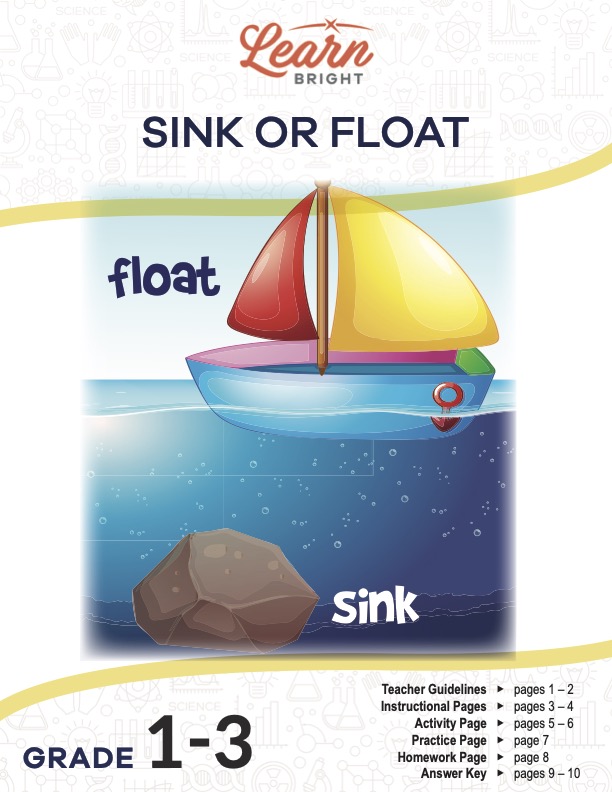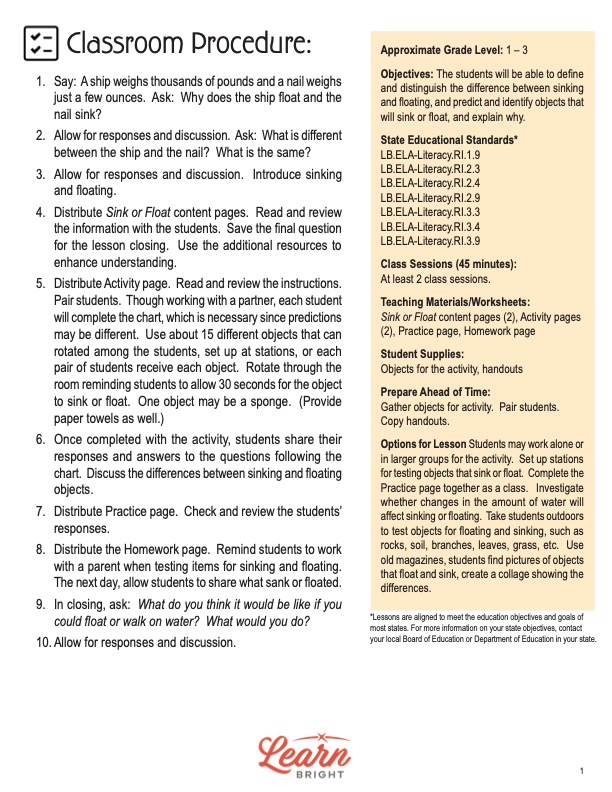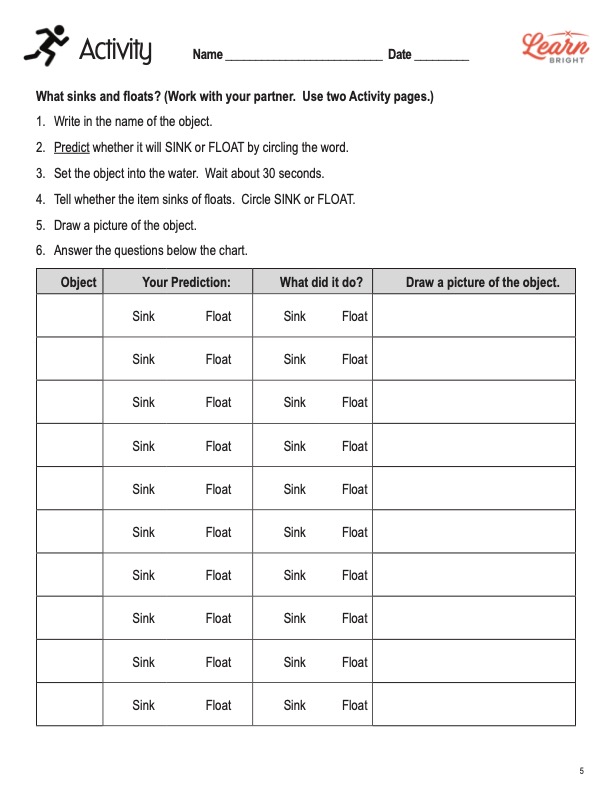Description
What our Sink or Float lesson plan includes
Lesson Objectives and Overview: Sink or Float provides a basic understanding of the concept of sinking and floating. Students will be able to define sink and float and distinguish between the two concepts. They will also predict whether certain objects will sink or float and explain why. This lesson is for students in 1st grade, 2nd grade, and 3rd grade.
Classroom Procedure
Every lesson plan provides you with a classroom procedure page that outlines a step-by-step guide to follow. You do not have to follow the guide exactly. The guide helps you organize the lesson and details when to hand out worksheets. It also lists information in the yellow box that you might find useful. You will find the lesson objectives, state standards, and number of class sessions the lesson should take to complete in this area. In addition, it describes the supplies you will need as well as what and how you need to prepare beforehand. For this lesson, make sure you gather various objects to use for the activity.
Options for Lesson
The “Options for Lesson” section provides several suggestions for additional ideas and activities to incorporate into the lesson if you have time. One idea is to set up stations for students to test objects that sink or those that float. Another option is to complete the Practice page together as a class. Have students investigate whether changing the amount of water will affect whether an object will float or sink. You could take students outdoors to test objects such as rocks, soil, branches, leaves, grass, etc. to see which ones float and which ones sink. One more idea is to have students find pictures in magazines of objects that float and sink and create a collage showing the differences.
Teacher Notes
The teacher notes page provides an extra paragraph of information to help guide the lesson. It stresses the importance of clearly explaining why certain things float while others sink, despite their size. You can use the blank lines to write down any other ideas or thoughts you have about the topic as you prepare.
SINK OR FLOAT LESSON PLAN CONTENT PAGES
Why Things Sink or Float
The Sink or Float lesson plan contains two pages of content. To start off, it suggests that students have most likely jumped into a pool, lake, or some other body of water. It then asks them what happened—did they sink or float? Everyone and everything in the world will either sink or float. Some really heavy objects float despite their weight. And some light objects sink.
A marble, for instance, is much lighter than a row boat. However, the marble sinks and the row boat floats. Additionally, if we add people to the boat, it still won’t sink but instead stay afloat on top of the water. Perhaps an object’s weight has nothing to do with whether or not it sinks or floats.
The reason objects behave in one way or another is all about density. Molecules make up all objects, and for some objects, those molecules are close together. Other objects, though, have molecules that are further apart. Density determines how close the molecules of an object are to each other.
Objects with more density have molecules that are closer together. It’s easier for these objects to sink. On the other hand, the further apart molecules are in an object, the less dense that object is and the easier it is for it to float in water. And any object with a higher density than water itself will always sink when placed in water.
Shapes and State of Matter
Students will discover that an object’s shape may affects whether it floats or sinks. A large ship or a small row boat will float because of their shape and design. In a boat, there is a big air pocket that allows it to stay on top of the water’s surface. An air pocket is an enclosure that holds air in and allows flotation.
A ball of clay is round in shape. If we drop it in water, it will sink to the bottom. However, if we change the shape to make it flat like a pancake, it will float instead. In a similar fashion, the metal that we use to build a ship will sink unless we reshape it properly.
Moving on to non-solid objects, we go back to the fact that any object will sink if its density is higher than that of water. So a liquid, like maple syrup, will also sink because it is denser than water. Not all liquids sink in water. Oil is a great example; it’s less dense than water and will thus float. With oil spills, the oil sits on top of the water and is not easy to remove.
What about gases? Air is made up of gases, and the more air an object contains, the more likely it will float. A raft or inner tube filled with air floats easily on top of water. Depending on how much air is in the raft, several people can sit inside or on top without worrying about sinking.
Buoyancy and Displacement
When an object floats better than another object, that means the first object is more buoyant. Buoyancy is the ability of an object to float in water or another liquid. It is the force that pushes up from below the water. As gravity tries to sink objects, buoyancy tries to make it float. A big cruise ship is more buoyant than a row boat because more of the cruise ship is in the water.
Speaking of cruise ships, a person on a cruise ship is less likely to get seasick because the ship moves less than a row boat does. Put another way, the ship displaces more water than the row boat. Displacement is when the water pushes up for rises and gets out of the way of an object.
A famous mathematician, Archimedes, discovered the concept of displacement. After he sat down in a bathtub, the water rose around him. When he left the tub, the water level went back down. He realized that the weight of the water that displaced his body was equal to the water’s buoyancy force. Scientists now call this idea the Archimedes principle.
SINK OR FLOAT LESSON PLAN WORKSHEETS
The Sink or Float lesson plan includes three worksheets: an activity worksheet, a practice worksheet, and a homework assignment. Each one will reinforce students’ comprehension of lesson material in different ways and help them demonstrate when they learned. Use the guidelines on the classroom procedure page to determine when to distribute each worksheet to the class.
SINK OR FLOAT ACTIVITY WORKSHEET
Students will work with a partner for the activity. You will provide about 15 objects for students to analyze. As they go around the room to look at each object, students will determine whether it will wink or float. They will write the name of the object in the first column of the table on the page. Then they will circle whether or not they think the object would sink or float. After they drop the item in water and wait around 30 seconds, they will circle whether the item sank or floated. Finally, they will draw a picture of the item in the last column.
Once everyone has gone around the room, they will answer a series of questions at the bottom of the second worksheet page. They must answer how many objects sink and how many stay afloat. Then they will write what those things have in common with each other.
FACT REVIEW PRACTICE WORKSHEET
The practice worksheet divides into three parts. The first part requires students to circle the correct word from a pair of choices in 10 sentences. For the second part, students will decide whether each of 10 statements is true (T) or false (F). Finally, the last section requires students to list five objects that will float and five objects that will sink.
AT-HOME EXPERIMENT HOMEWORK ASSIGNMENT
Like the practice worksheet, the homework assignment has two parts. For the first section, students must match descriptions to the correct term. There is a word bank on the right side of the page with the terms they can choose from. Students will then experiment at home with objects they find around the house. With the help of a parent, they will fill a sink or bucket with water. They will find 20 objects and see which ones sink or float. (There is a table on which they will keep track of this information.) At the end, they will explain which objects surprised them and why.
Worksheet Answer Keys
The lesson plan provides answer keys for the practice and homework assignments. Correct answers are in red to make it easy to compare them to students’ responses. Because some prompts on the assignments are objective, students’ answers may vary. If you choose to administer the lesson pages to your students via PDF, you will need to save a new file that omits these pages. Otherwise, you can simply print out the applicable pages and keep these as reference for yourself when grading assignments.









